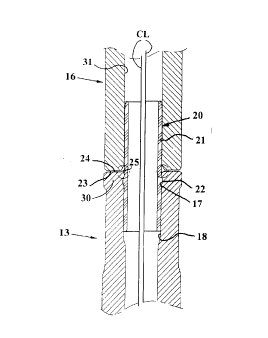Note: Claims are shown in the official language in which they were submitted.
5
Claims
1. An air operated down-the-hole hammer (10) for rock drilling, comprising:
a generally cylindrical casing (11),
a drill chuck (12) mounted at one end of said casing to receive a drill bit
(13),
a drill sub (14) attached to the other end of said casing,
a foot valve (20) located in a central passageway (18) in a drill bit anvil
(30) and
projecting from an impact surface (24) of the anvil, said foot valve being
intermittently
enclosed by a central bore of a reciprocating piston (16) to transfer
pressurized air
through the drill bit,
characterized in that the intersection of the drill bit (13)/piston (16)
impact surface (24,23) and the drill bit/piston passageway (18,31) is provided
with a circumferential projection (25) integrated with the drill bit
(13)/piston (16)
to deflect jet streams of fluid during drilling.
2. The down-the-hole hammer according to claim 1,
characterized in that the circumferential projection (25) has a generally
conical cross-section formed by a radially internal entrance surface (26), a
curved top (27) and a radially external deflection surface (28), said
deflection
surface (28) forming an angle (a) with the center line (CL) of the drill bit
(13)/piston (16).
3. The down-the-hole hammer according to claim 2,
characterized in the angle (a) is acute, preferably at least 45°.
4. The down-the-hole hammer according to claim 1,
characterized in that the piston (16)/drill bit (13) is provided with a
chamfer (29) for intermittently housing the projection (25) during drilling.
5. A percussive drill bit comprising a body having: a front drilling face,
a central passageway (18) extending from a rear end (30) of the body in
direction towards the drilling face to conduct flushing medium to the drilling
face,
6
said rear end comprising an impact surface (24) surrounding the passageway
(18),
said central passageway (18) being adapted to receive a foot valve (20) to
transfer
pressurized air through the drill bit,
characterized in that the intersection of the drill bit (13) impact surface
(24) and the drill bit passageway (18) is provided with a circumferential
projection (25) integrated with the drill bit (13) to deflect jet streams of
water
during drilling.
6. The drill bit according to claim 5,
characterized in that the circumferential projection (25) has a generally
conical cross-section formed by a radially internal entrance surface (26), a
curved top (27) and a radially external deflection surface (28), said
deflection
surface (28) forming an angle (a) with the center line (CL) of the drill bit
(13).
7. The drill bit according to claim 5,
characterized in that the angle (a) is acute, preferably at least 45°.
